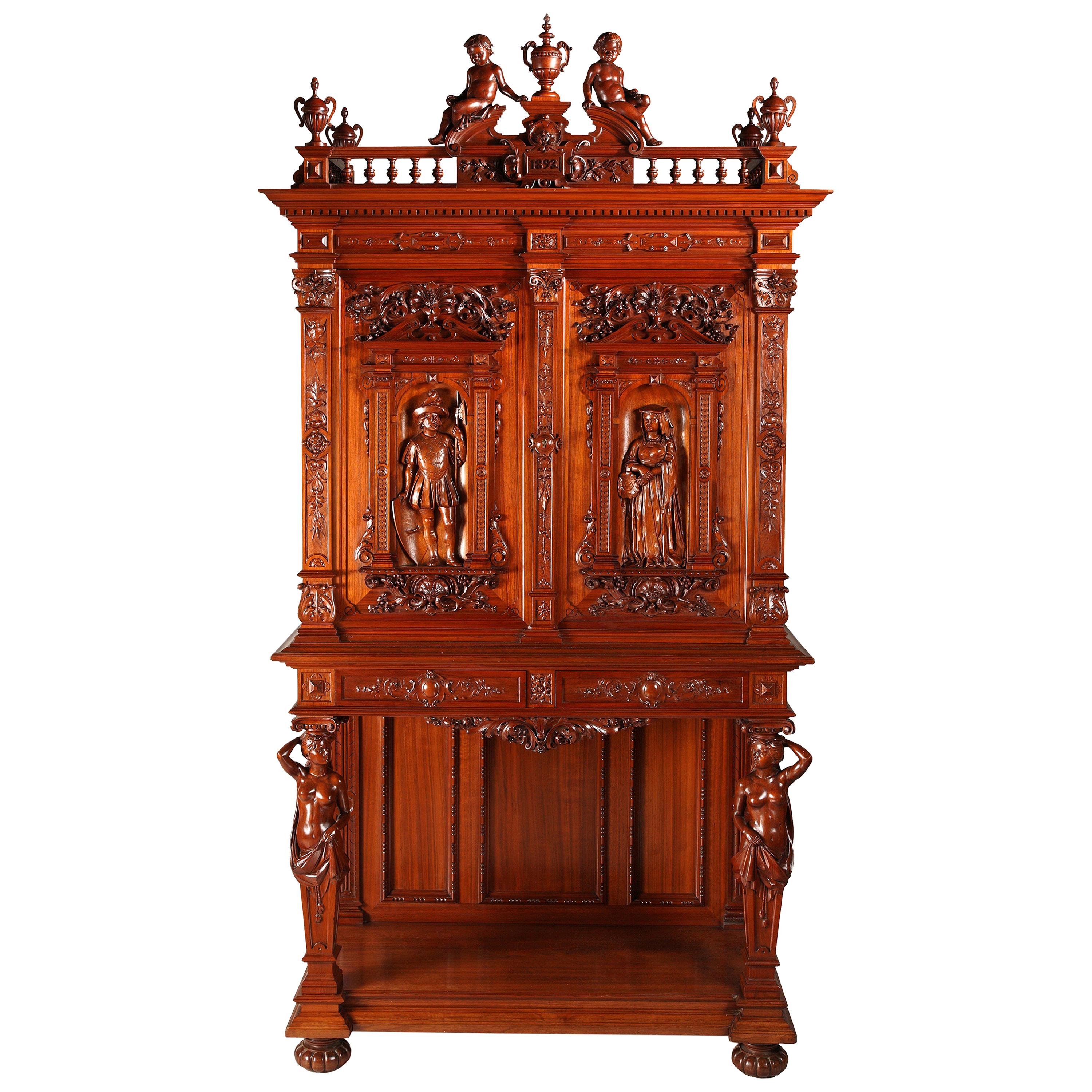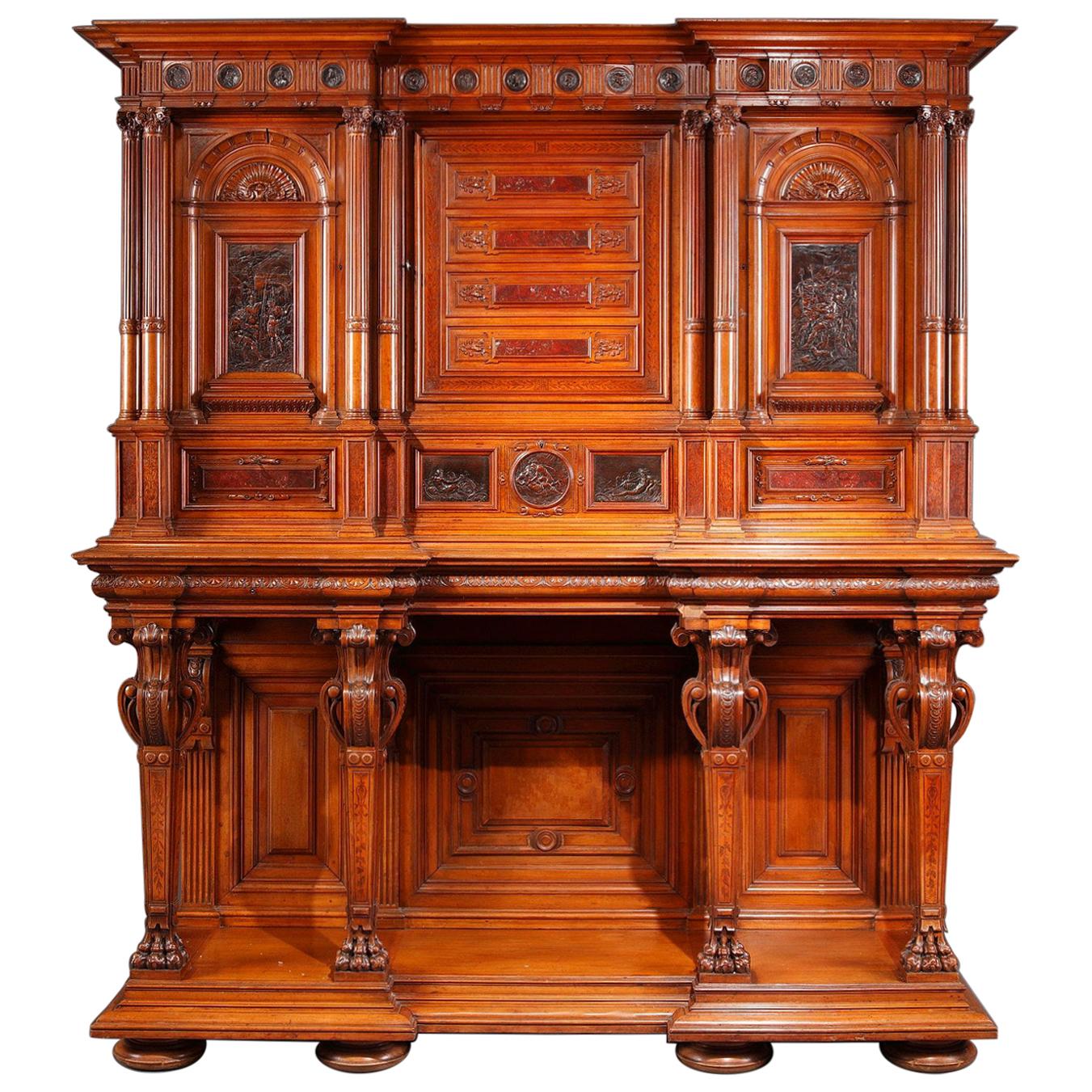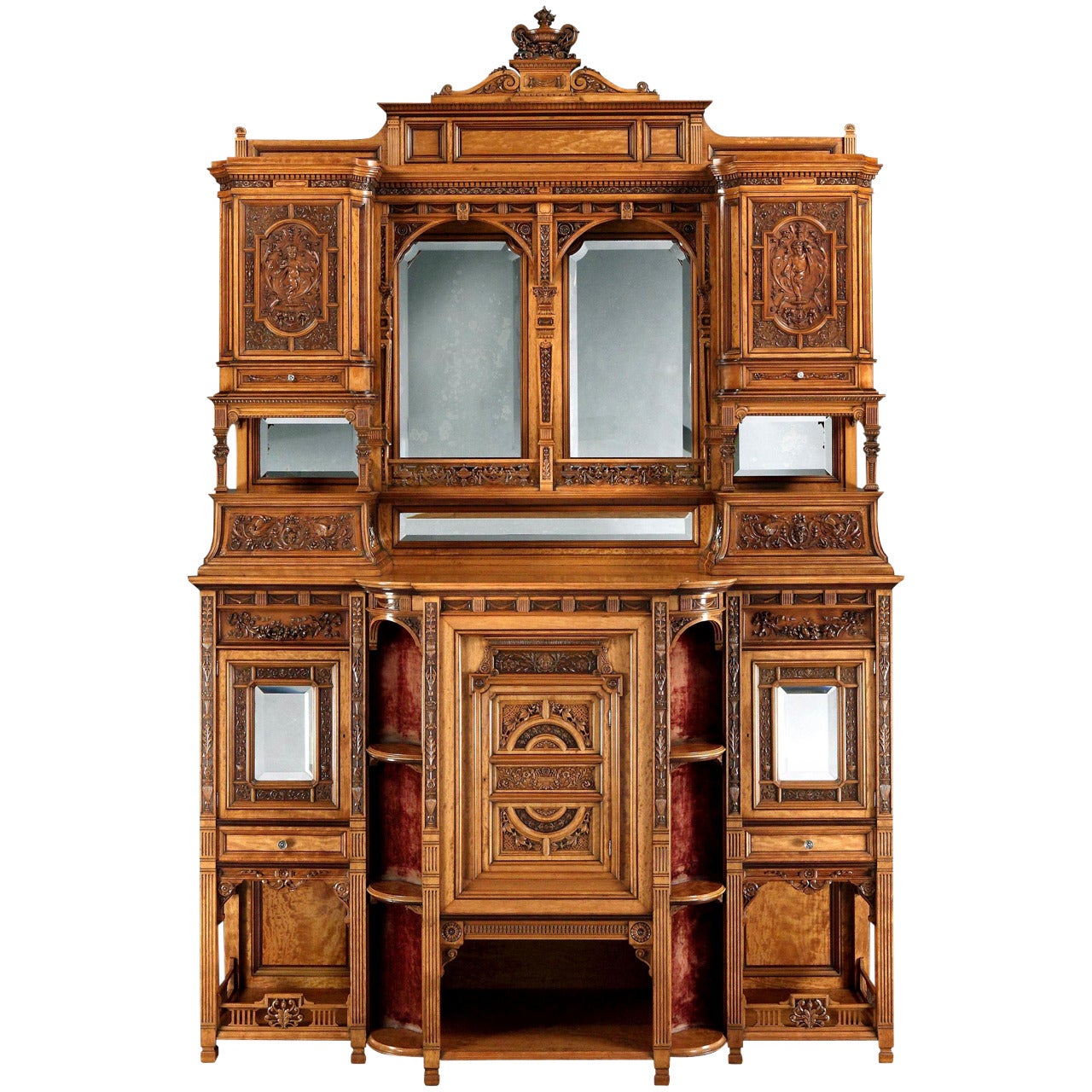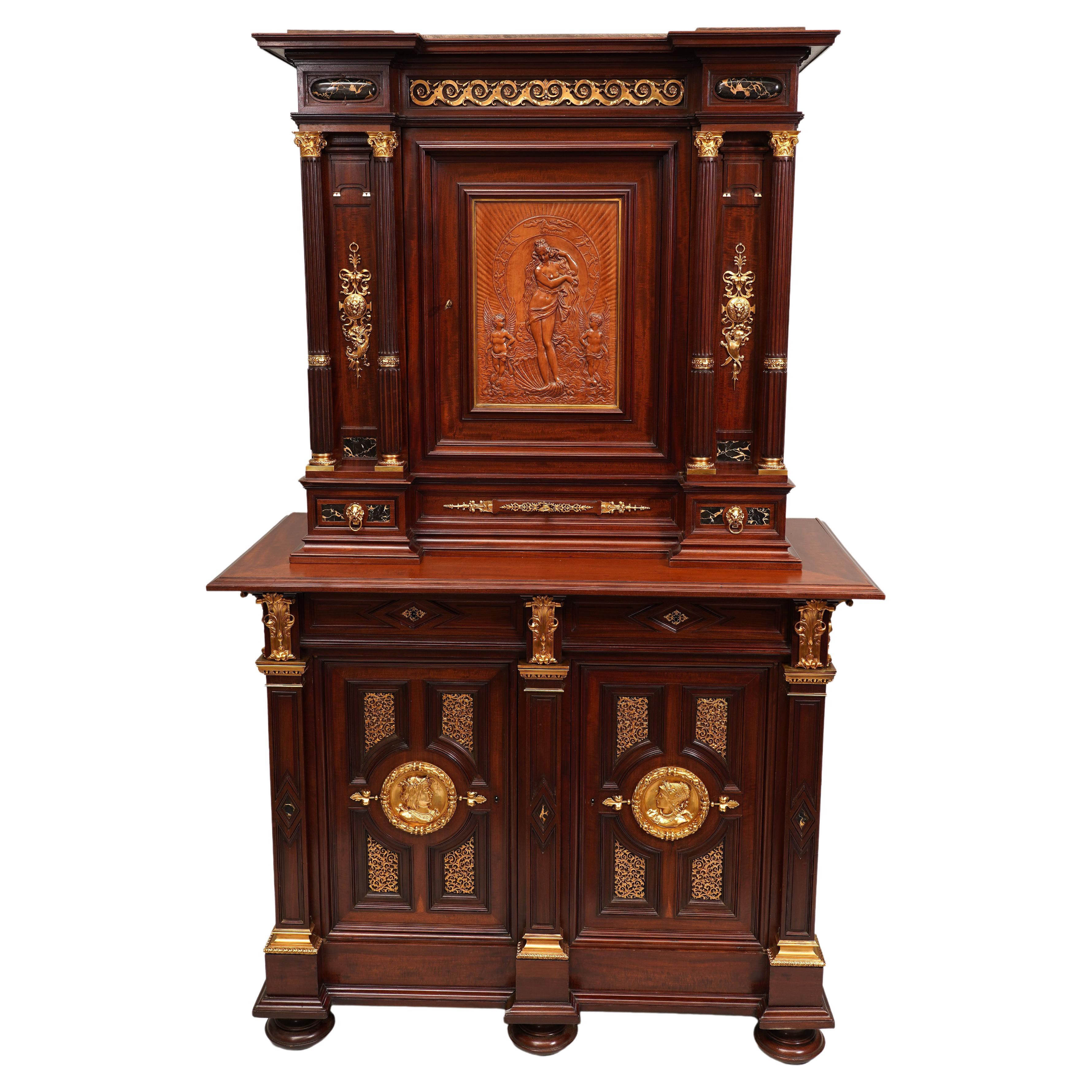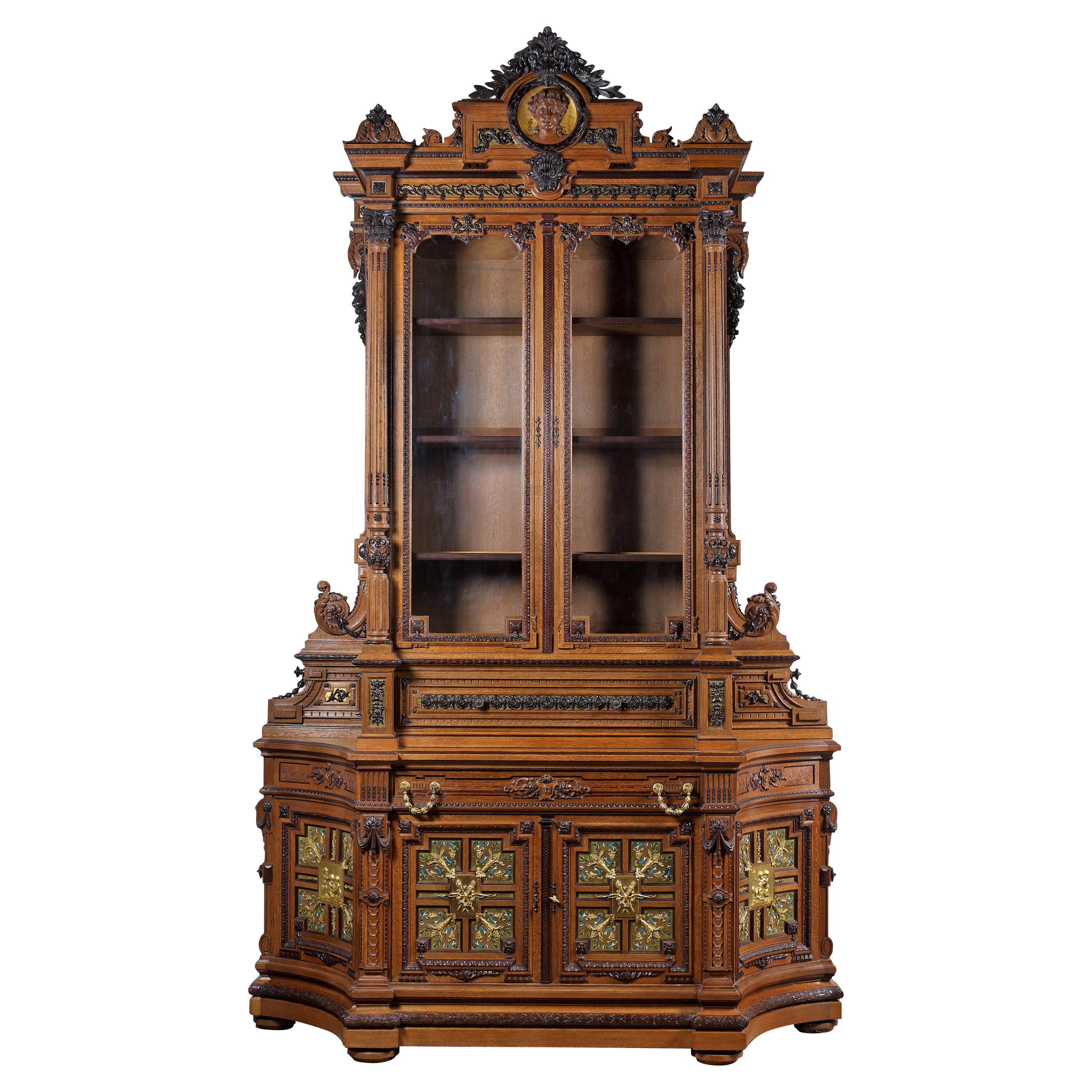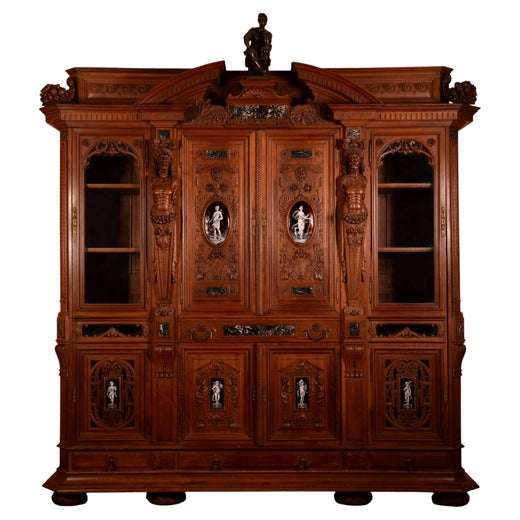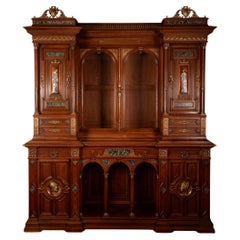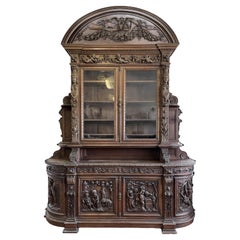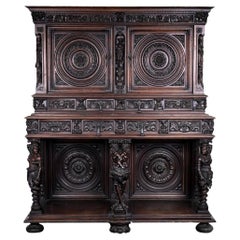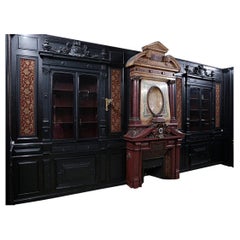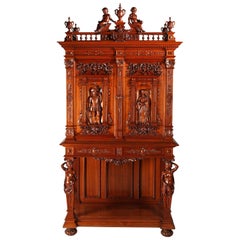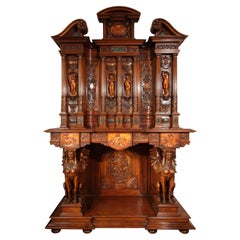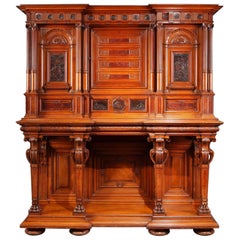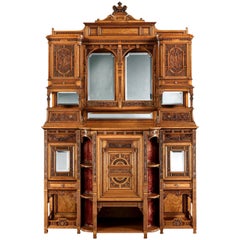Items Similar to Neo-Renaissance style cabinet with painted enamels signed by Theophile Soyer
Want more images or videos?
Request additional images or videos from the seller
1 of 19
Neo-Renaissance style cabinet with painted enamels signed by Theophile Soyer
$86,113.84
£64,191.92
€72,500
CA$120,030.63
A$130,452.65
CHF 68,939.12
MX$1,578,195.48
NOK 858,587.69
SEK 810,989.47
DKK 552,120.42
About the Item
This two-bodies Neo-Renaissance style display cabinet with two glass doors was made in the second half of the nineteenth century in waxed walnut. The enamel plates, remarkable in their execution, are signed with the initials of Theophile Soyer (1853-1940), great enameler of the second half of the 19th century. Enamels in black and white hues, which suggest an early work as they are far different from the better-known production of Theophile Soyer , as well as the cabinet making work, allow to date it more precisely from the years 1875- 1880.
In the middle of the cabinet, on the main panels, two oval bulging medallions represent on one side “Apollo slaying the Python”, on the other “Diana the Huntress”. Apollo, a quiver on his back, arrow in the hand and with a triumphant glare, spans a dead snake on the ground, while Diana is represented with her traditional attributes: a quiver and a dog at her side, the goddess with knotted hair and uncovered breast is preparing, with a certain nonchalance, to loose an arrow. The two medallions are set in carved frames adorned with bouquets of flowers, lions and friezes of pearls. On the doors of the lower cupboards, four panels adorned with rectangular enamel plates, also signed Theophile Soyer , represent the seasons incarnated by putti. While spring is symbolized by the rebirth of Flora, summer prepares winter by the harvesting of ears of wheat. Autumn is the season of grape harvest: the putto holds in one of his hands the fruits of his crop and in the other a cup that will host the drink. In winter, the putto is covered with a drapery moving in the fresh air of the wind. The enamels are made with great virtuosity and adds to this piece of furniture a great preciousness. The square and rectangular Black Marquina marble pieces that decorate this work are echoed by the enamels they only enhance. These enamels are indeed of a great brilliance and their figures of a brilliant whiteness contrast with the black background. The gold-colored elements, such as the quivers of the God and the Goddess, enhance the whole. The furniture is capped with an architected broken pediment whose cut sides are adorned with cornucopias from which spread pomgranates. In the center, on a pedestal, stands a bronze statue made by the Barbedienne foundry representing Lorenzo II de Medici, Duke of Urbino (1492-1519), sitting and thoughtful. It is a representation of the statue decorating the tomb of the latter made by Michelangelo in the sixteenth century inside the Medici Chapels in Florence. This statue will have a great fortune in the nineteenth century through many editions. On either side of the central cupboard, two faun-looking Atlants were carved with great finesse and great attention to detail. Their bust, depicting the features of an aging body, rests on a pedestal and their bearded face is capped with an oriental-inspired turban. These two enigmatic and mysterious figures are typical of the Neo-Renaissance style and the very nineteen-ish taste for curiosities. In addition to bronzes, marble and enamels, it is remarkable to note the lavishness of the carved ornamental repertoire such as the curves and laurel branches on the pediment, the lion heads and baskets of fruits on the central doors, the few naturalist rosettes or even foliage carved around enamel plates with putti. The lavish decor of this furniture reflects a taste for detail that goes hand in hand with the Neo-Renaissance style, appeared in the 1830s in a context of rediscovering history and past styles. The cabinetmaking work of this firm, which can be said to be a Parisian work, is in fact characteristic of workshops production of the period specialized in the Neo-Renaissance style such as the Grohé brothers or the Damon, Namur et Cie house, such as this Neo-Renaissance style credenza carved in natural walnut on display at the 1878 World Fair. Like the one we present here, this credenza is composed of two glazed bodies making a library and connected by a chest opening with two doors. The furniture is also surmounted by a pediment where, between the arches, a pedestal is decorated with a bronze work of art reproducing the famous statue of Lorenzo II de Medici. Founded in 1840 by Antoine Krieger, then sold to M. Recault before being taken over by Damon, Namur et Cie, this house quickly acquired a certain importance and imposed itself on the French and European markets. The locks are marked “Huby fils serrurier Paris” (“Huby son locksmith Paris”). Auguste Luchet calls him in his account of the 1867 World Fair the “young prince of the locksmiths” and his Renaissance-style creations were famous.
Our piece of furniture takes its decor and theme in the Renaissance but also its technique. Painted enamel and carved wood are among the techniques that artists intend to put back into fashion, both by challenge and by the desire to perpetuate traditional and artisanal skills in a nineteenth century marked by industrialization and development. Painted enamel, which developed in Limoges from 1530 to the beginning of the 17th century, belongs in fact to the crafts of the Renaissance, until its consecration in the second half of the century, time of pastiches of all kinds. Reappeared around 1840, painted enamels were thus, from the 1860s, practiced by many artists. Among them, Paul Soyer , sculptor by profession and father of Theophile, was the collaborator, since 1863, of Claudius Popelin (1825-1892), painter and enameller thanks to whom the enamel painted “in the manner of Limoges” found a prominent place. Paul Soyer later created his own studio which enjoyed a certain success thanks to the decorations he created to adorn furniture and objects and specialized in enamel painted white figures on a black background like the enamels of the Renaissance. With this piece of furniture, Theophile Soyer , who will later be one of the great enamellers of the Art Nouveau style with a production in bright and shimmering colors, seems to be in line with the paternal style, at a time when he is still his collaborator. The work of this piece of furniture is therefore the fruit of a youthful work, which sets it apart from the usual production of Theophile Soyer .
Born in 1853 in Paris and died in 1940, Théophile Soyer began with his father who, according to Michel Dillange, was “more of a craftsman than an artist”, which led him to push his son to follow Fine Arts lessons in order to be the creator of ever more artistic compositions. After this training, where he learns the copy of the Olds, Theophile Soyer follows the courses of Yvon and Levasseur. He began to work with enamel in Courbevoie, then joined the workshop of his father rue Saint-Sauveur, workshop he resumed in 1896. He exhibited for the first time at the Salon of 1870 where he presented an enamel copy of a work by Elder Barber, Apollo killing the Python, a theme found on one of the plates adorning this piece of furniture. This concordance supports the realization of this piece of furniture and enamels in the years 1870-1880. He then exhibited regularly from 1875 to 1882 as well as in the Exhibitions of the Central Union of Fine Arts from 1876. He also received a silver medal at the 1889 World's Fair and a gold medal at the 1900's. In 1909, he moved to open a new workshop rue de Bondy where he remained until the end of the First World War. Theophile Soyer took an active part in the artistic life of his time: he was vice-president of the Union Chamber of Ceramics and Glass and President of the Society of Eclectics, a humorous society founded in 1872 by aquafortists and poets where he meets Dr. Gachet. He was the husband of Eugenie Dejoux, painter-enameler from Geneva, from which he will have a daughter, Jeanne, also destined to work with his parents before getting married in 1906. A certain technicality characterizes this piece of furniture and corresponds to the desire of the decorating artists of the time to reconnect with the arts and crafts. This piece of furniture, between an object of cabinet-making and an art object, is thus characteristic of the Neo-Renaissance style and the very nineteen-ish taste for past styles. Above all, it allows to appreciate the early, precious and sophisticated work of one of the greatest enamellers of the second half of the 19th century.
- Creator:Théophile Soyer (Artist)
- Dimensions:Height: 99.81 in (253.5 cm)Width: 88.59 in (225 cm)Depth: 22.84 in (58 cm)
- Style:Renaissance Revival (Of the Period)
- Materials and Techniques:
- Place of Origin:
- Period:
- Date of Manufacture:1860
- Condition:
- Seller Location:SAINT-OUEN-SUR-SEINE, FR
- Reference Number:Seller: 10911 / 195911stDibs: LU7662233073922
Théophile Soyer
Théophile Soyer attended the classes of Yvon and Levasseur and began at the Salon of 1870 with the enamel copy of a work by Le Barbier aîné. He then exhibited regularly from 1875 to 1882. He was married in 1879 to Léa, born Dejoux, nicknamed Lucie, a student of Lamunière. He won a silver medal at the 1889 “World's Fair” and a gold medal in 1900. He was president of the Eclectic Society, a humorous society founded in 1872 and vice-president of the Union's Chamber of Ceramics and Glass.
About the Seller
No Reviews Yet
Recognized Seller
These prestigious sellers are industry leaders and represent the highest echelon for item quality and design.
1stDibs seller since 2022
5 sales on 1stDibs
Typical response time: 15 hours
- ShippingRetrieving quote...Shipping from: SAINT-OUEN-SUR-SEINE, France
- Return Policy
Authenticity Guarantee
In the unlikely event there’s an issue with an item’s authenticity, contact us within 1 year for a full refund. DetailsMoney-Back Guarantee
If your item is not as described, is damaged in transit, or does not arrive, contact us within 7 days for a full refund. Details24-Hour Cancellation
You have a 24-hour grace period in which to reconsider your purchase, with no questions asked.Vetted Professional Sellers
Our world-class sellers must adhere to strict standards for service and quality, maintaining the integrity of our listings.Price-Match Guarantee
If you find that a seller listed the same item for a lower price elsewhere, we’ll match it.Trusted Global Delivery
Our best-in-class carrier network provides specialized shipping options worldwide, including custom delivery.More From This Seller
View AllÉdouard LIÈVRE, Paul SORMANI, Neo-Renaissance ceremonial sideboard and buffet
By Edouard Lievre, Paul Sormani
Located in SAINT-OUEN-SUR-SEINE, FR
Description
Designed by Édouard Lièvre, this sideboard and serving trolley represent a masterpiece of the neo-Renaissance style. Their rediscovery represents a major event in the fie...
Category
Antique 1870s French Renaissance Revival Buffets
Materials
Marble, Bronze
Large Napoleon III Style Oak Bookcase – Four Seasons Theme
Located in SAINT-OUEN-SUR-SEINE, FR
Impressive Napoleon III style oak bookcase, richly carved with the allegorical theme of the Four Seasons. The lower doors feature high-relief panels with cherubic figures depicting s...
Category
Antique 19th Century French Napoleon III Bookcases
Materials
Oak
Chimeric dressor
Located in SAINT-OUEN-SUR-SEINE, FR
This imposing walnut carved cupboard sideboard is a tour de force of artistic invention and technical mastery. Close to Tuscan Neo-Renaissance production of the second half of the 19...
Category
Antique Late 19th Century Italian Renaissance Revival Cabinets
Materials
Wood
$104,524
Louis XVI Style Panelling with Louis XVI Period Mantel and Trumeau
Located in SAINT-OUEN-SUR-SEINE, FR
Rare Napoleon III style paneled room in blackened wood (stained beech) with its fireplace in stucco in imitation of porphyry.
The fireplace, which is the centerpiece of this paneled...
Category
20th Century French Napoleon III Panelling
Materials
Bronze
Napoleon III walnut fireplace surmounted by an important alcove
Located in SAINT-OUEN-SUR-SEINE, FR
This impressive fireplace made in walnut wood during the second half of the 19th century shows a very rich and eclectic decoration typical of the Second Empire's taste.
Its rolled ja...
Category
Antique 19th Century French Napoleon III Fireplaces and Mantels
Materials
Walnut
Louis XVI Style Paneling with Louis XVI Period Mantel and Trumeau
Located in SAINT-OUEN-SUR-SEINE, FR
This Louis XVI style paneled room is composed of two shelves and cupboards with double doors made of wood painted in light green in the 20th century.
They frame a Louis XVI period mantel sculpted in Saint-Anne grey marble with a fluted decor on the header and the jambs. The mantel is accompanied by its trumeau also from the same period, made of sculpted woodn painted in the same colors as the rest of the room. The decor are risen up with gold painting such as the beautiful Love allegory recognizable thanks to the kissing birds...
Category
Vintage 1950s French Louis XVI Panelling
Materials
Wood
You May Also Like
Renaissance Style Wooden Cabinet Attributed to H.A. Fourdinois, France, 1893
Located in PARIS, FR
A wooden cupboard, elaborately carved throughout, dated "1893" on the crest and attributed to H.A. Fourdinois. The upper section with a pair of cherubs at the center of a balustrade ornamented with two-handled urns, two architectonic doors below, carved with lady and gentleman in niches surrounded by extensive carving with classical motifs. The lower section with two drawers above a standing female caryatid support at each front corner. The all reposing on four gadronned round feet.
The Fourdinois company was founded in 1835 by Alexandre-Georges Fourdinois (1799-1871). The Universal Exhibition held in London in 1851 was undoubtedly their first great artistic and public success. Winning the Great medal for a neo-Renaissance buffet...
Category
Antique 1890s French Renaissance Cabinets
Materials
Wood
$15,678 Sale Price
40% Off
Renaissance Style "Four Seasons" Cabinet by M. Lerolle, France, Circa 1890
By Lerolle
Located in PARIS, FR
Signed " Meubles D’Art, M. Lerolle, Fabricant, 61, Rue des Sts-Peres. Paris "
Remarkable carved wood cabinet, richly sculpted in the Neo-Renaissance style, and inlaid with vert de m...
Category
Antique 1890s French Renaissance Revival Cabinets
Materials
Marble
Neo-Renaissance Cabinet by G.F. Quignon, Universal Exhibition of Paris 1889
By Frederic Gustave Quignon
Located in PARIS, FR
Presented at the Universal Exhibition of Paris in 1889
Important sculpted and engraved natural wood, patinated bronze and Griotte de Campan red marble inlaid Neo-Renaissance style cabinet.
The upper part is composed of a frieze of bronze medallions separated by triglyphs and supported by ribbed columns with Corinthian capitals. There are eight of these columns paired at the front and two simple columns at the rear. The facade presents an alternation of bronzes in niches and cartouches, of marble slates in cartouches sometimes flanked by palmettes, and of engraved motives of laurel and foliage scrolls. The upper part opens with three leaves and three mobile compartments. The belt carved with acanthus leaves opens with two drawers. This cabinet is supported by four richly sculpted tapered feet ending with claws. Four fluted pilasters are inscribed in the moulded back as counterparts. The whole ensemble stands on a moulded plinth and eight rounded feet.
Neo Renaissance Cabinet...
Category
Antique 1880s French Renaissance Cabinets
Materials
Marble, Bronze
$128,279 Sale Price
20% Off
English 19th Century Carved Satinwood Cabinet
Located in London, GB
A magnificently carved display cabinet of exhibition quality.
The maker has chosen to use a richly grained satinwood and executed the carving with extraordinary fluency and precis...
Category
Antique Late 19th Century English Renaissance Revival Cabinets
Materials
Mirror, Satinwood
Neo-Renaissance Cabinet by P. Sormani and attr. to E. Lièvre, France, Circa 1870
By Edouard Lievre, Paul Sormani
Located in PARIS, FR
Signed twice on the lock P. SORMANI 10 rue Charlot Paris
Rare neo-Renaissance cabinet in carved wood and Portor marble, adorned with chiseled and gilded bronze.
The upper, part, surmounted by a frieze of posts and marble cabochons, consists of a central door decorated with a carved panel representing the birth of Venus, framed by two pairs of ringed and fluted columns with Corinthians capitals in gilded bronze revealing two doors with secret opening. Two drawers with lion’s head shaped handles and a central drawer decorated with tracery in gilded bronze complete the upper part of this cabinet.
In the lower part, two drawers on the belt with diamond...
Category
Antique 1870s French Renaissance Cabinets
Materials
Marble, Bronze
$64,615 Sale Price
38% Off
Wooden & Enameled Display Sideboard Attributed to H.A Fourdinois, France, c1867
Located in PARIS, FR
Important two-tiered sideboard attributed to H.A. Fourdinois made in natural and carved wood : the lower part made up of four panels, two concave ones and two doors, richly ornated with a polychrome enameled floral decoration and gilt bronze plaques.
A large dual drawer is surmounted by the upper part of the sideboard, opening with two glazed doors, framed by detached columns. The entire unit is topped with a pediment onto which a female bust is carved in relief within a medallion on a gilt background.
With a matching set of twelve chairs.
The Forney library in Paris preserves order registers of the Fourdinois as well as sketches books and pictures representing pieces of furniture made by the Fourdinois workshops. In this documentation, some elements enable us to link this sideboard with Henri-Auguste Fourdinois’ productions, such as the large scrolls linking the upper part to the lower part of the sideboard, as well as the detached columns carved at their lower third. (picture n°1 attached)
Notebook containing ink-sketches coming from the Fourdinois workshop shows a project for a pelmet, beautified with a centering trophy composed of a torch and a quiver within in a foliage wreath, this motif obviously reused by the Fourdinois on the central decoration of the panels of our sideboard. (picture n°2 attached)
The firm of Fourdinois, considered during the Second Empire as the greatest furniture manufacturer in Paris, was founded in 1835 by Alexandre-Georges Fourdinois (1799-1871). It was developped in the context of the Expositions Universelles. At the time, the firm already produces furniture of the Neo-Renaissance style, such as a dresser that won the Great Medal at the London Universal Exhibition of 1851. The son, Henri-Auguste Fourdinois (1830-1907), joined the firm in 1860 and will become head of the firm in 1867. The high quality of his designs was remarked at the Universal Exhibition in 1862, when the jury awarded him two medals « for Excellence of Composition and Execution ». Henri-Auguste, now sole in charge, brought the firm to the summit of its achievements at the 1867 Universal Exhibition in Paris by winning the Grand Prize for his stand. Apart from the commissions he executed for the « Mobilier de la Couronne », he also produced high quality furniture for the Parisian bourgeoisie. The firm is at its zenith during the years 1862-1880. At this time, it is considered as an example to follow for other cabinet-makers, whether they are French, British or American.
Through the quality of execution and the extreme care taken in the decoration of furniture, H.-A. Fourdinois was particularly appreciated by Napoleon III and Eugenie...
Category
Antique 1860s French Renaissance Sideboards
Materials
Enamel, Bronze
More Ways To Browse
Enamel Signs
Enamel Signs Antique
Signed Cabinet
Arts And Crafts Display Cabinet
French Renaissance Cabinet
17th Century Cabinet On Stand
Limoges France Hand Painted Plates
French Art Nouveau Bronze Busts
French Enamel Sign
Diana Huntress
Art Colored Cut Glass Plates
Renaissance Neo Furniture
Four Seasons Arts And Crafts
Hand Carved French Basket Of Flowers
Antique Locksmith
Bronze Statue On Marble Pedestal
Chest On Stand 17th Century
Door Rosette
